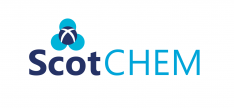Welcome to the ScotCHEM protein-ligand docking course¶
Created by Dr Bruce F. Milne, University of Aberdeen.
Introduction¶
This course is designed to give you an introduction to both the theory and practice of computational protein-ligand docking simulation.
As the material is aimed at individuals who want to use protein-ligand docking in their own research, it is assumed that you are already familiar with the basic concepts of the interaction of drug-like molecules with proteins and want to learn how to simulate this process computationally. We will therefore not go into the fundamental theories of protein-ligand interactions here but will move straight to the computational chemistry side of things.
Note
Take your time!
Depending on your familiarity with computational chemistry and/or Linux the time you will need to complete this course will vary enormously.
This is not a problem.
The material has been set out in what is hopefully a logical order but feel free to skip ahead or go back and forth until you are comfortable with it.
Understanding what is going on in the calculations and being able to rationally and (hopefully) confidently interpret the results is the whole point of this, not just being able to make the calculations run!
It is very easy now to download and then just run docking software with no real understanding of what is actually going on in the calculations. Unfortunately, this means that people are often misled by docking results and where this sort of computational tool is meant to facilitate experimental drug discovery research it can end up hindering it instead. In the worse case scenario incorrect use of the software and/or misinterpretation of simulation data can lead to results that are unreliable or just plain wrong. Sadly, many examples of this already exist in the literature and the best way to be able to start to filter these cases out (and avoid adding more!) is to try to get to grips with the basics.
With this in mind, the current course will try to provide you with a solid foundation in several important background areas such as molecule file formats, force fields for geometry/energy calculations and finally scoring functions for predicting protein-ligand docking configurations and energetics. Please bear in mind though that each of these are large topics on their own, so here we will merely be scratching the surface.
The course also contains a large practical component and you will get a grounding in necessary Linux use and software installation as well as creating ligand structures, preparing the protein and ligand for docking and finally running and analyzing the docking simulation itself.
Advanced topics like tuning the search algorithm, including protein side chain flexibility or docking macrocyclic ligands are beyond the scope of this course but information on these subjects (and more) can be found in the documentation pages of the AutoDock Vina software which we will be using here.
During the practical work a few things will need to be done at the command line. However, for the main part we will make use of graphical software tools. This makes many steps much easier than if they were done at the command line but will provide you with the necessary input files that will allow you to then make use of the full power of vina as a command line tool should you want to. This will also prepare you to move on to the more advanced tutorials in the vina documentation which will require command line operation.
